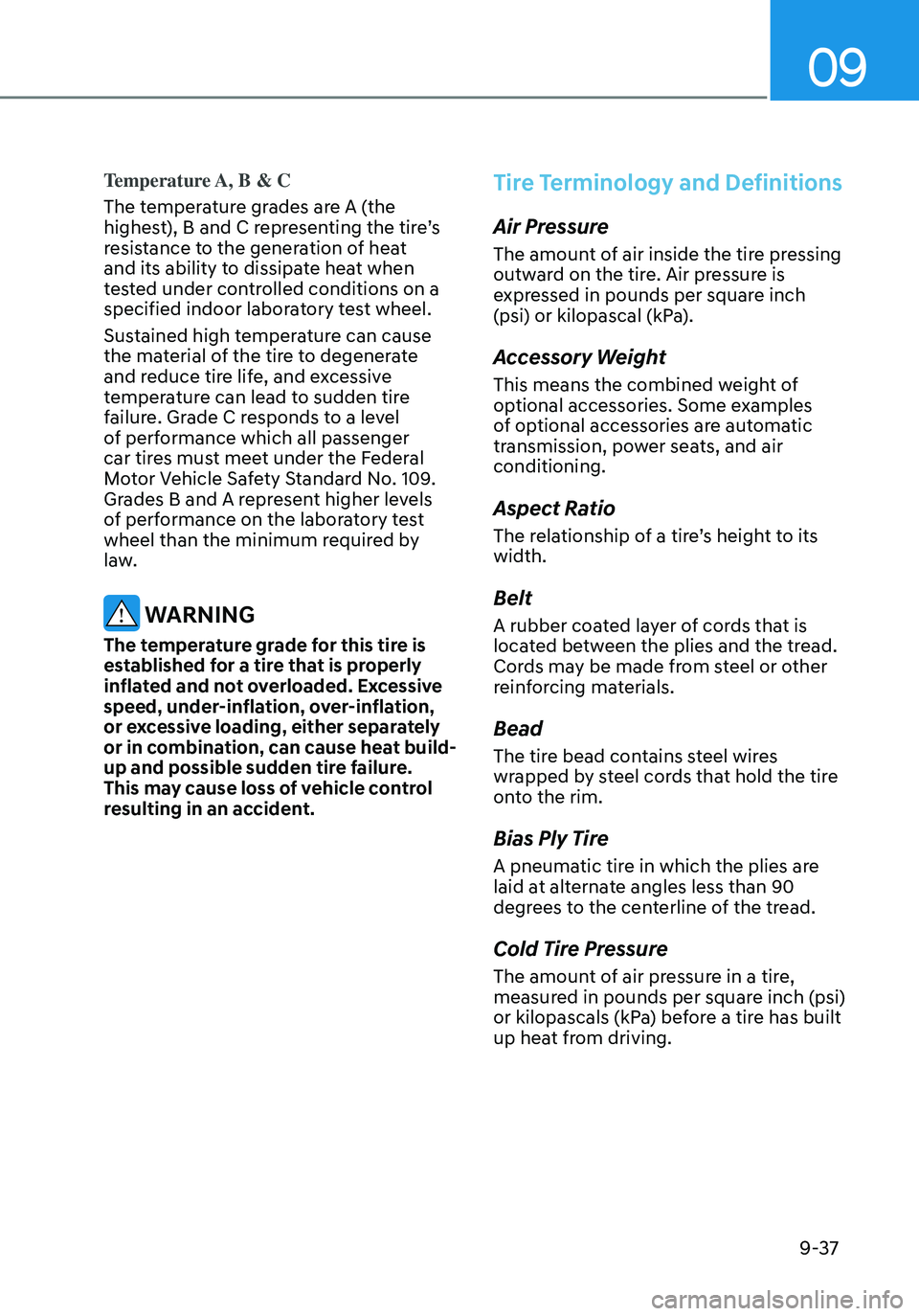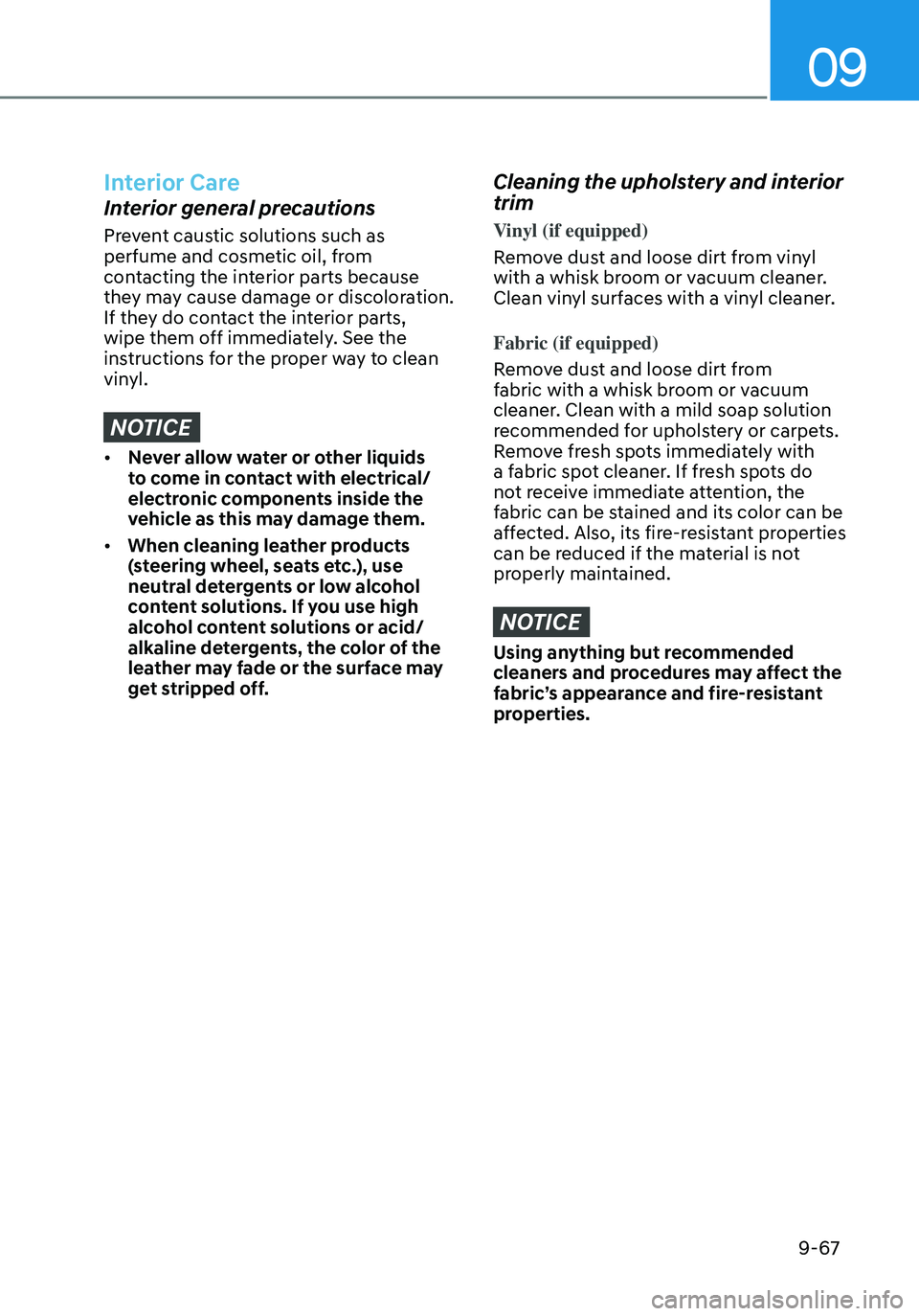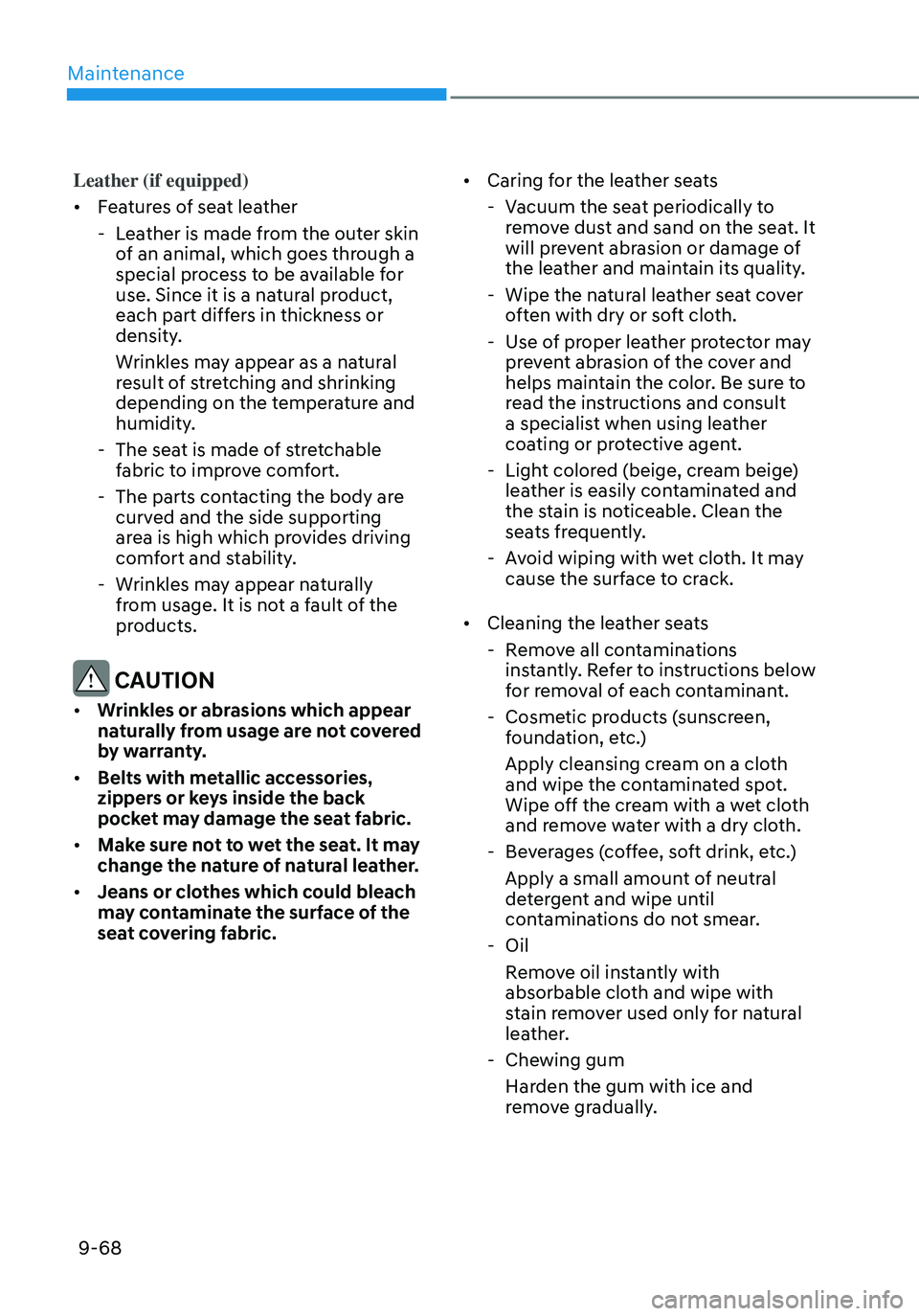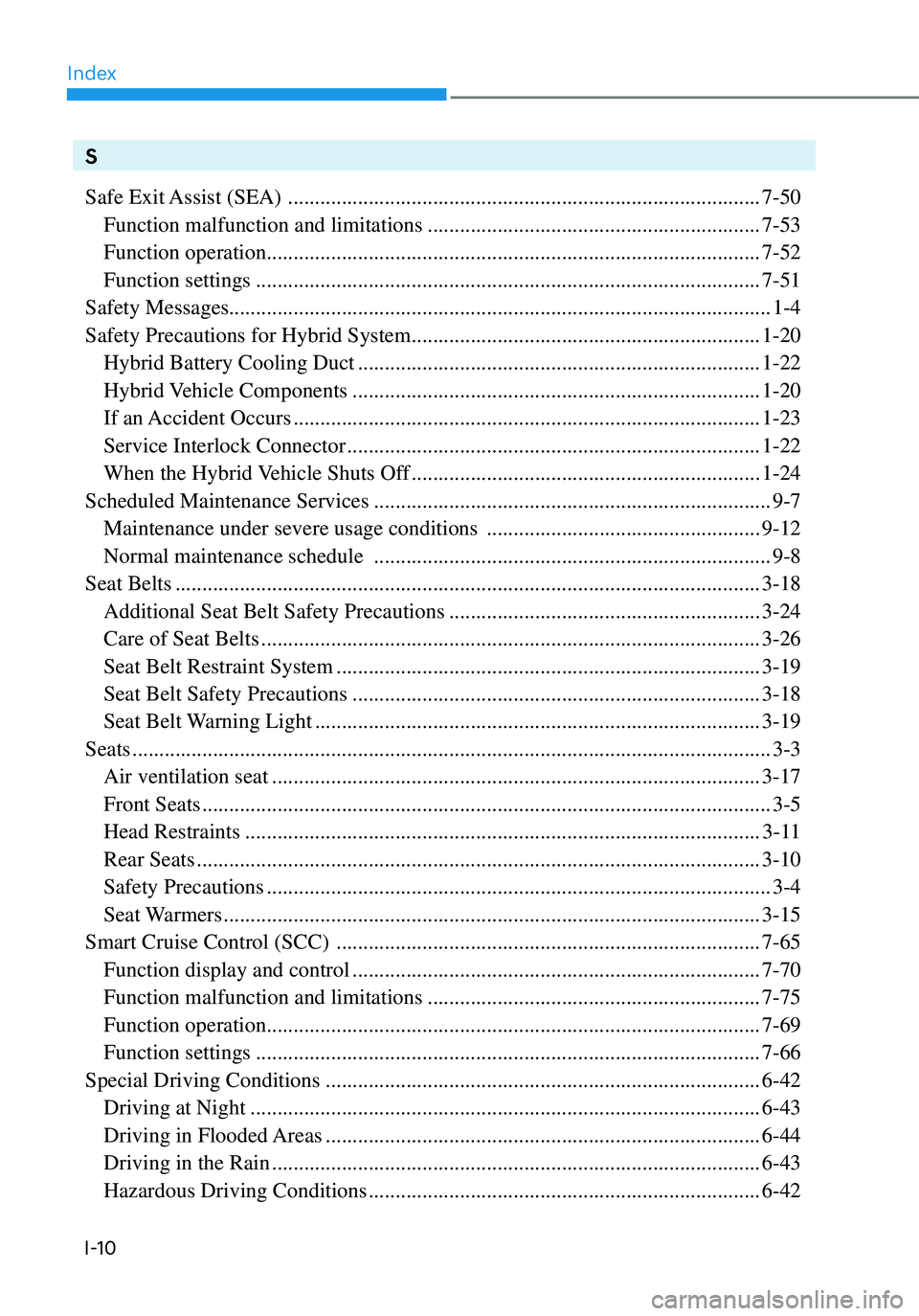2021 HYUNDAI ELANTRA HYBRID seats
[x] Cancel search: seatsPage 506 of 555

09
9-37
Temperature A, B & C
The temperature grades are A (the
highest), B and C representing the tire’s
resistance to the generation of heat
and its ability to dissipate heat when
tested under controlled conditions on a
specified indoor laboratory test wheel.
Sustained high temperature can cause
the material of the tire to degenerate
and reduce tire life, and excessive
temperature can lead to sudden tire
failure. Grade C responds to a level
of performance which all passenger
car tires must meet under the Federal
Motor Vehicle Safety Standard No. 109.
Grades B and A represent higher levels
of performance on the laboratory test
wheel than the minimum required by
law.
WARNING
The temperature grade for this tire is
established for a tire that is properly
inflated and not overloaded. Excessive
speed, under-inflation, over-inflation,
or excessive loading, either separately
or in combination, can cause heat build-
up and possible sudden tire failure.
This may cause loss of vehicle control
resulting in an accident.
Tire Terminology and Definitions
Air Pressure
The amount of air inside the tire pressing
outward on the tire. Air pressure is
expressed in pounds per square inch
(psi) or kilopascal (kPa).
Accessory Weight
This means the combined weight of
optional accessories. Some examples
of optional accessories are automatic
transmission, power seats, and air
conditioning.
Aspect Ratio
The relationship of a tire’s height to its
width.
Belt
A rubber coated layer of cords that is
located between the plies and the tread.
Cords may be made from steel or other
reinforcing materials.
Bead
The tire bead contains steel wires
wrapped by steel cords that hold the tire
onto the rim.
Bias Ply Tire
A pneumatic tire in which the plies are
laid at alternate angles less than 90
degrees to the centerline of the tread.
Cold Tire Pressure
The amount of air pressure in a tire,
measured in pounds per square inch (psi)
or kilopascals (kPa) before a tire has built
up heat from driving.
Page 536 of 555

09
9-67
Interior Care
Interior general precautions
Prevent caustic solutions such as
perfume and cosmetic oil, from
contacting the interior parts because
they may cause damage or discoloration.
If they do contact the interior parts,
wipe them off immediately. See the
instructions for the proper way to clean
vinyl.
NOTICE
• Never allow water or other liquids
to come in contact with electrical/
electronic components inside the
vehicle as this may damage them.
• When cleaning leather products
(steering wheel, seats etc.), use
neutral detergents or low alcohol
content solutions. If you use high
alcohol content solutions or acid/
alkaline detergents, the color of the
leather may fade or the surface may
get stripped off.
Cleaning the upholstery and interior
trim
Vinyl (if equipped)
Remove dust and loose dirt from vinyl
with a whisk broom or vacuum cleaner.
Clean vinyl surfaces with a vinyl cleaner.
Fabric (if equipped)
Remove dust and loose dirt from
fabric with a whisk broom or vacuum
cleaner. Clean with a mild soap solution
recommended for upholstery or carpets.
Remove fresh spots immediately with
a fabric spot cleaner. If fresh spots do
not receive immediate attention, the
fabric can be stained and its color can be
affected. Also, its fire-resistant properties
can be reduced if the material is not
properly maintained.
NOTICE
Using anything but recommended
cleaners and procedures may affect the
fabric’s appearance and fire-resistant
properties.
Page 537 of 555

Maintenance
9-68
Leather (if equipped)
• Features of seat leather
-Leather is made from the outer skin
of an animal, which goes through a
special process to be available for
use. Since it is a natural product,
each part differs in thickness or
density.
Wrinkles may appear as a natural
result of stretching and shrinking
depending on the temperature and
humidity.
-The seat is made of stretchable
fabric to improve comfort.
-The parts contacting the body are
curved and the side supporting
area is high which provides driving
comfort and stability.
-Wrinkles may appear naturally
from usage. It is not a fault of the
products.
CAUTION
• Wrinkles or abrasions which appear
naturally from usage are not covered
by warranty.
• Belts with metallic accessories,
zippers or keys inside the back
pocket may damage the seat fabric.
• Make sure not to wet the seat. It may
change the nature of natural leather.
• Jeans or clothes which could bleach
may contaminate the surface of the
seat covering fabric. •
Caring for the leather seats
-Vacuum the seat periodically to
remove dust and sand on the seat. It
will prevent abrasion or damage of
the leather and maintain its quality.
-Wipe the natural leather seat cover
often with dry or soft cloth.
-Use of proper leather protector may
prevent abrasion of the cover and
helps maintain the color. Be sure to
read the instructions and consult
a specialist when using leather
coating or protective agent.
-Light colored (beige, cream beige)
leather is easily contaminated and
the stain is noticeable. Clean the
seats frequently.
-Avoid wiping with wet cloth. It may
cause the surface to crack.
• Cleaning the leather seats
-Remove all contaminations
instantly. Refer to instructions below
for removal of each contaminant.
-Cosmetic products (sunscreen,
foundation, etc.)
Apply cleansing cream on a cloth
and wipe the contaminated spot.
Wipe off the cream with a wet cloth
and remove water with a dry cloth.
-Beverages (coffee, soft drink, etc.)
Apply a small amount of neutral
detergent and wipe until
contaminations do not smear.
-Oil
Remove oil instantly with
absorbable cloth and wipe with
stain remover used only for natural
leather.
-Chewing gum
Harden the gum with ice and
remove gradually.
Page 552 of 555

Index
I-10
S
Safe Exit Assist (SEA)
........................................................................\
................7-50
Function malfunction and limitations ..............................................................7-53
Function operation ........................................................................\
....................7-52
Function settings ........................................................................\
......................7-51
Safety Messages ........................................................................\
............................. 1-4
Safety Precautions for Hybrid System
.................................................................1-20
Hybrid Battery Cooling Duct ........................................................................\
...1-22
Hybrid Vehicle Components ........................................................................\
....1-20
If an Accident Occurs ........................................................................\
...............1-23
Service Interlock Connector ........................................................................\
.....1-22
When the Hybrid V ehicle Shuts Off .................................................................1-24
Scheduled Maintenance Services
........................................................................\
..9-7
Maintenance under severe usage conditions ...................................................9-12
Normal maintenance schedule ........................................................................\
..9-8
Seat Belts
........................................................................\
.....................................3-18
Additional Seat Belt Safety Precautions ..........................................................3-24
Care of Seat Belts ........................................................................\
.....................3-26
Seat Belt Restraint System ........................................................................\
.......3-19
Seat Belt Safety Precautions ........................................................................\
....3-18
Seat Belt Warning Light ........................................................................\
...........3-19
Seats
........................................................................\
...............................................3-3
Air ventilation seat ........................................................................\
...................3-17
Front Seats ........................................................................\
..................................3-5
Head Restraints ........................................................................\
........................3-11
Rear Seats ........................................................................\
.................................3-10
Safety Precautions ........................................................................\
......................3-4
Seat Warmers ........................................................................\
............................3-15
Smart Cruise Control (SCC)
........................................................................\
.......7-65
Function display and control ........................................................................\
....7-70
Function malfunction and limitations ..............................................................7-75
Function operation ........................................................................\
....................7-69
Function settings ........................................................................\
......................7-66
Special Driving Conditions
........................................................................\
.........6-42
Driving at Night ........................................................................\
.......................6-43
Driving in Flooded Areas ........................................................................\
.........6-44
Driving in the Rain ........................................................................\
...................6-43
Hazardous Driving Conditions ........................................................................\
.6-42